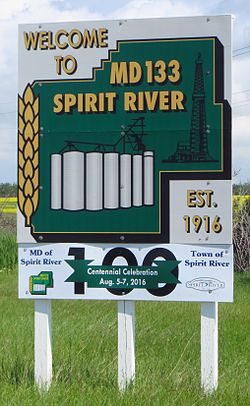The Municipal District of Spirit River No. 133 is a municipal district (MD) in northwest Alberta, Canada, north of Grande Prairie. Located in the Upper Peace Region, its municipal office is located in the Town of Spirit River. With an area of 683.6 km2 (263.9 sq mi), it is the smallest municipal district in Alberta.[3]
Spirit River No. 133 | |
|---|---|
| Municipal District of Spirit River No. 133 | |
 Welcome sign | |
 Location within Alberta | |
| Country | Canada |
| Province | Alberta |
| Region | Northern Alberta |
| Planning region | Upper Peace |
| Established | 1916 |
| Incorporated | 1916 |
| Government | |
| • Reeve | Stanley W. Bzowy |
| • Governing body | MD of Spirit River Council |
| • Administrative office | Spirit River |
| Area (2021)[2] | |
| • Land | 679.86 km2 (262.50 sq mi) |
| Population (2021)[2] | |
• Total | 649 |
| • Density | 1/km2 (3/sq mi) |
| Time zone | UTC−7 (MST) |
| • Summer (DST) | UTC−6 (MDT) |
| Website | mdspiritriver.ab.ca |
History
editThe MD of Spirit River No. 133 was incorporated in 1916.
Geography
editCommunities and localities
edit|
The following urban municipalities are surrounded by the MD of Spirit River No. 133.[4]
The following hamlets are located within the MD of Spirit River No. 133.[4]
|
The following localities are located within the MD of Spirit River No. 133.[5]
|
Demographics
edit| Year | Pop. | ±% |
|---|---|---|
| 1916 | 899 | — |
| 1921 | 888 | −1.2% |
| 1926 | 893 | +0.6% |
| 1931 | 1,800 | +101.6% |
| 1936 | 1,890 | +5.0% |
| 1941 | 1,828 | −3.3% |
| 1946 | 1,404 | −23.2% |
| 1951 | 1,406 | +0.1% |
| 1956 | 1,413 | +0.5% |
| 1961 | 1,318 | −6.7% |
| 1966 | 1,243 | −5.7% |
| 1971 | 1,022 | −17.8% |
| 1976 | 857 | −16.1% |
| 1981 | 891 | +4.0% |
| 1986 | 848 | −4.8% |
| 1991 | 812 | −4.2% |
| 1996 | 809 | −0.4% |
| 2001 | 824 | +1.9% |
| 2006 | 662 | −19.7% |
| 2011 | 713 | +7.7% |
| 2016 | 700 | −1.8% |
| Source: Statistics Canada [6][7][8][9][10][11][12][13][14][15][16] | ||
In the 2021 Census of Population conducted by Statistics Canada, the MD of Spirit River No. 133 had a population of 649 living in 273 of its 315 total private dwellings, a change of -7.3% from its 2016 population of 700. With a land area of 679.86 km2 (262.50 sq mi), it had a population density of 1.0/km2 (2.5/sq mi) in 2021.[2]
In the 2016 Census of Population conducted by Statistics Canada, the MD of Spirit River No. 133 had a population of 700 living in 274 of its 306 total private dwellings, a -1.8% change from its 2011 population of 713. With a land area of 683.6 km2 (263.9 sq mi), it had a population density of 1.0/km2 (2.7/sq mi) in 2016.[3]
See also
editReferences
edit- ^ Alberta Municipal Affairs: Municipal Officials Search
- ^ a b c "Population and dwelling counts: Canada, provinces and territories, and census subdivisions (municipalities)". Statistics Canada. February 9, 2022. Retrieved February 9, 2022.
- ^ a b "Population and dwelling counts, for Canada, provinces and territories, and census subdivisions (municipalities), 2016 and 2011 censuses – 100% data (Alberta)". Statistics Canada. February 8, 2017. Retrieved February 8, 2017.
- ^ a b "Specialized and Rural Municipalities and Their Communities" (PDF). Alberta Municipal Affairs. June 3, 2024. Retrieved June 14, 2024.
- ^ "Standard Geographical Classification (SGC) 2006, Economic Regions: 4819054 - Spirit River No. 133, geographical codes and localities, 2006". Statistics Canada. March 5, 2010. Retrieved August 12, 2012.
- ^ "Table IV: Population of Prairie Provinces by Municipalities, Local Improvement Districts or Unorganized Territorial Units, 1916". Census of Prairie Provinces, 1916. Ottawa: Department of Trade and Commerce. 1918.
- ^ "Table 6: Population by census divisions of Alberta classified by municipalities for census years, 1921 and 1926". Census of Prairie Provinces, 1926. Ottawa: Department of Trade and Commerce. 1929.
- ^ "Table 6: Population by census subdivisions, 1926-1946". Census of the Prairie Provinces, 1946. Vol. I: Population. Ottawa: Dominion Bureau of Statistics. 1949.
- ^ "Table 6: Population by sex, for census subdivisions, 1956 and 1951". Census of Canada, 1956. Vol. I: Population. Ottawa: Dominion Bureau of Statistics. 1958.
- ^ "Table 9: Population by census subdivisions, 1966 by sex, and 1961". 1966 Census of Canada. Western Provinces. Vol. Population: Divisions and Subdivisions. Ottawa: Dominion Bureau of Statistics. 1967.
- ^ "Table 3: Population for census divisions and subdivisions, 1971 and 1976". 1976 Census of Canada. Census Divisions and Subdivisions, Western Provinces and the Territories. Vol. Population: Geographic Distributions. Ottawa: Statistics Canada. 1977.
- ^ "Table 2: Census Subdivisions in Alphabetical Order, Showing Population Rank, Canada, 1981". 1981 Census of Canada. Vol. Census subdivisions in decreasing population order. Ottawa: Statistics Canada. 1982. ISBN 0-660-51563-6.
- ^ "Table 2: Population and Dwelling Counts, for Census Divisions and Census Subdivisions, 1986 and 1991 – 100% Data". 91 Census. Vol. Population and Dwelling Counts – Census Divisions and Census Subdivisions. Ottawa: Statistics Canada. 1992. pp. 100–108. ISBN 0-660-57115-3.
- ^ "Population and Dwelling Counts, for Canada, Provinces and Territories, and Census Divisions, 2001 and 1996 Censuses – 100% Data (Alberta)". Statistics Canada. Retrieved May 28, 2019.
- ^ "Population and dwelling counts, for Canada, provinces and territories, and census subdivisions (municipalities), 2006 and 2001 censuses – 100% data (Alberta)". Statistics Canada. January 6, 2010. Retrieved May 28, 2019.
- ^ "Census Profile, 2016 Census". Statistics Canada. February 8, 2017. Retrieved May 28, 2019.
